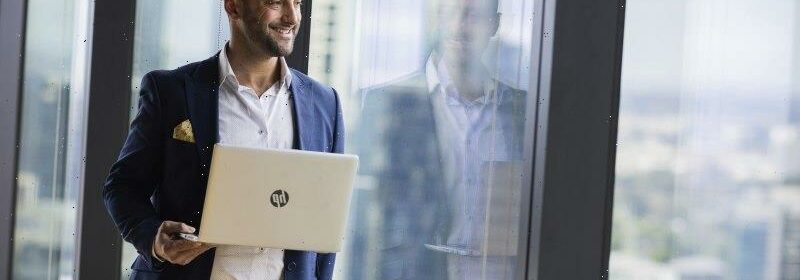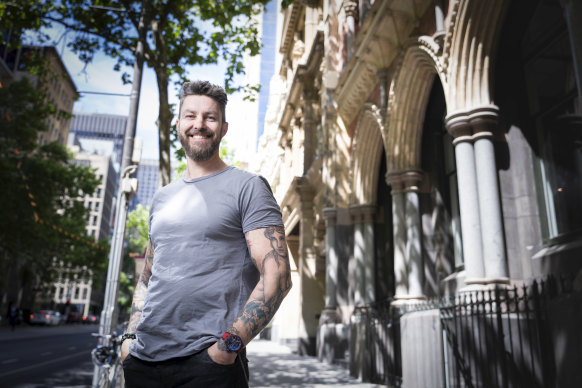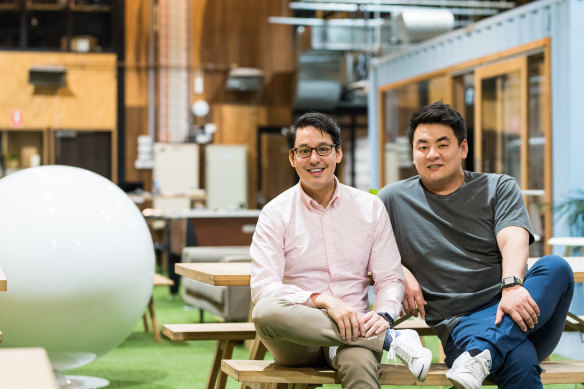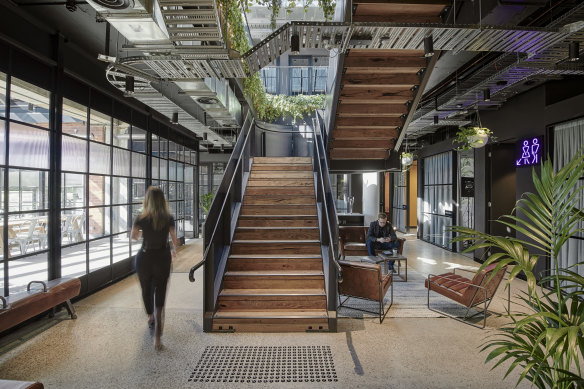Sleek fit-outs, trendy bars: The offices bucking the CBD occupancy trends

CBD offices continue to sit empty with record low occupancies, but coworking spaces are bucking the trend, thriving in the uncertainty of the post-pandemic work world.
New research from commercial real estate agency Colliers finds that flexible workspaces now account for 4.5 per cent of the total office stock in Melbourne, up from 1.7 per cent in 2019. In Sydney, it’s 2.8 per cent, up from 1 per cent.
Work Club founder Soren Trampedach outside Melbourne CBD’s Olderfleet building on Collins Street.Credit:Eamon Gallagher
Industry experts say coworking spaces are recovering at a faster rate than traditional workplaces, with short-term leases a key drawcard.
In July, Melbourne’s office occupancy sat at 38 per cent, according to the most recent Property Council data, compared to just over 50 per cent in Sydney and Brisbane.
Sami Schiavi, Colliers’ head of flexible workspace, said the coworking sector flourished in turbulent times.
“Businesses are not having to commit to lengthy lease terms or really expensive fit-outs,” she said.
Coworking spaces – also known as flexible workspaces – were badly hit during the pandemic. Some operators didn’t survive. But many who did say they are now thriving, with their spaces full and new sites opening.
“The more uncertainty in the world, the more flex grows,” Work Club founder Soren Trampedach said. “How can people commit to 10, even five years on a lease, when they have no idea what will happen in six months?”
Trampedach’s high-end Melbourne site – where Work Club also runs the building’s concierge, restaurant and bar – is at capacity with about 700 members and a long waitlist.
For business owner Luke Borg, being at Work Club allows the headcount at his company Capstone Property Recruitment to expand and contract easily.
Capstone Property Recruitment’s Luke Borg is a member at Work Club.Credit:Paul Jeffers
“Whereas you have to take a gamble if you move to fixed, larger traditional premises.”
Schiavi said that adding to coworking’s appeal is increased choice (there are 90 operators in Melbourne and 79 in Sydney) and, in turn, quality.
She said the sector was bigger in Melbourne because rents were cheaper than in Sydney and there had been a migration of businesses out of the CBD since COVID-19, leading to a surge in suburban coworking sites.
Creative Cubes founder Tobi Skovron runs five Melbourne locations, with two to follow. His new venue in Collingwood, which spans three storeys and includes a Peloton studio, opened this week with one-fifth of the space already taken.
“Operators think of themselves as hospitality companies … Wired to create an experience where people want to come to the office.”
Skovron isn’t opening any CBD locations. People didn’t want long commutes anymore, he said. “We are about building world-class facilities closer to home.”
Skovron said coworking spaces were a “massive cog in the wheel for the future of work”.
Trampedach said the “hook” was what many conventional offices struggled to offer: flexible memberships, sleek fit-outs, trendy bars and cafes, social events and workshops.
It’s sometimes the stuff coworking spaces can be mocked for – the flowing beer and kombucha, on-site Peloton bikes, roller rink vibes – but the reality is, it seems to be working.
The Commons co-founders Cliff Ho (left) and Tom Ye in 2017.
Data from coworking space marketplace Rubberdesk shows that the amount of vacant desks in Melbourne’s CBD rose by 10 per cent in the three months to June, while in Sydney’s CBD it fell by 23 per cent.
A lifting of the work-from-home recommendations last week is expected to boost the CBD but Brad Krauskopf, co-chair of Flexible Workspace Australia and chief executive of Hub Australia, said he expected companies to lean on coworking spaces to engage their staff.
“Most operators think of themselves as hospitality companies,” Krauskopf said. “We’re wired to create an experience where people want to come to the office.”
The Commons co-founder Cliff Ho has seven coworking spaces in Melbourne, with another planned. “Even at our CBD site, every office is completely full and there’s a waitlist,” Ho said.
Creatives Cubes in Carlton.
Ho said his spaces offered companies flexibility while they establish their return-to-work policy.
“We’ve seen bigger teams come in who are downsizing because they don’t need as much office space anymore.”
Dr Julian Waters-Lynch, an RMIT lecturer of entrepreneurship and organisational design, said some businesses would eventually leave coworking spaces but he didn’t expect to see a reduction in the number of workspaces.
“The structural shift towards remote flexible and hybrid work is only beneficial for coworking,” he said.
Given their expertise at creating a “good vibe”, Waters-Lynch said the future for coworking space operators was in managing whole office buildings, like Work Club.
A 2020 report by commercial real estate firm JLL predicted that demand for flexible space would keep rising as a result of COVID-19, accounting for 30 per cent of all office space by 2030.
Trampedach is confident support for coworking will stick.
“It’s not going to go back to what it was,” he said. “If we can improve a business’ ability to attract and retain people and give them full flexibility … why would they consider going back to something archaic?”
The Morning Edition newsletter is our guide to the day’s most important and interesting stories, analysis and insights. Sign up here.
Most Viewed in National
From our partners
Source: Read Full Article



